It’s that time of year again. It’s time to design the annual employee survey.
As your team starts pulling the pieces together, you can’t help but feel a little bit of anxiety.
You believe in the importance of employee satisfaction surveys. Nevertheless, there’s been a lot of criticism in recent years, including complaints that employee surveys:
- Are too long
- Ask irrelevant questions
- Don’t elicit honest responses
But it is possible to produce an employee satisfaction survey that gives you the data you need while also providing a positive employee experience.
To do this, you need to pick the right questions for your survey that provide the most amount of information.
Employee satisfaction isn't something that you build and then stop working on.
You have to be in constant communication with your employees to make sure their expectations are met and they're currently happy at your organization.
This is especially true during times of change.
Here's how we can help you improve employee satisfaction:
Our platform automatically collects employee feedback on job satisfaction at regular intervals (70% of our clients opt for monthly surveys).
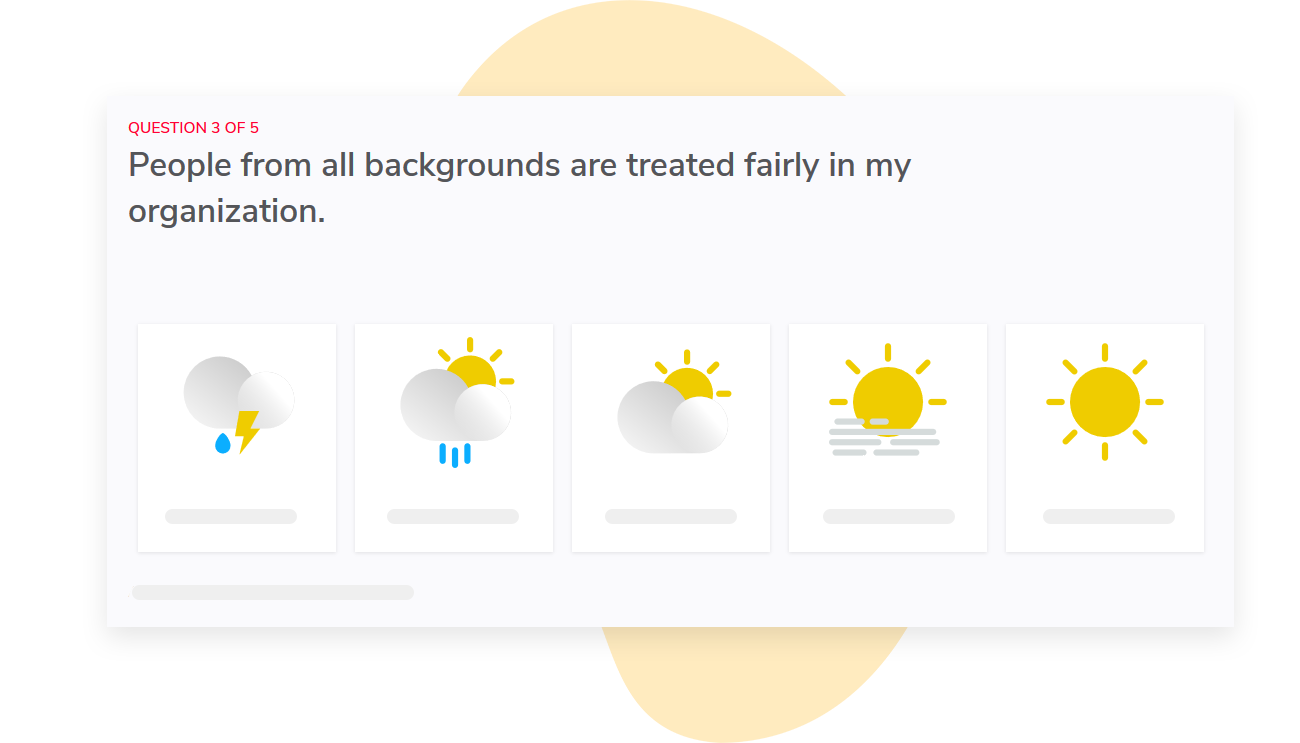
Sparkbay then presents the results in intuitive reports with a clear score out of 10.
With the help of these reports, you’re able to track employee satisfaction in real-time, and understand your top improvement opportunities.
You can also segment your data based on manager, department, tenure and more, or benchmark yourself against companies in the same industry as yours using our proprietary dataset.
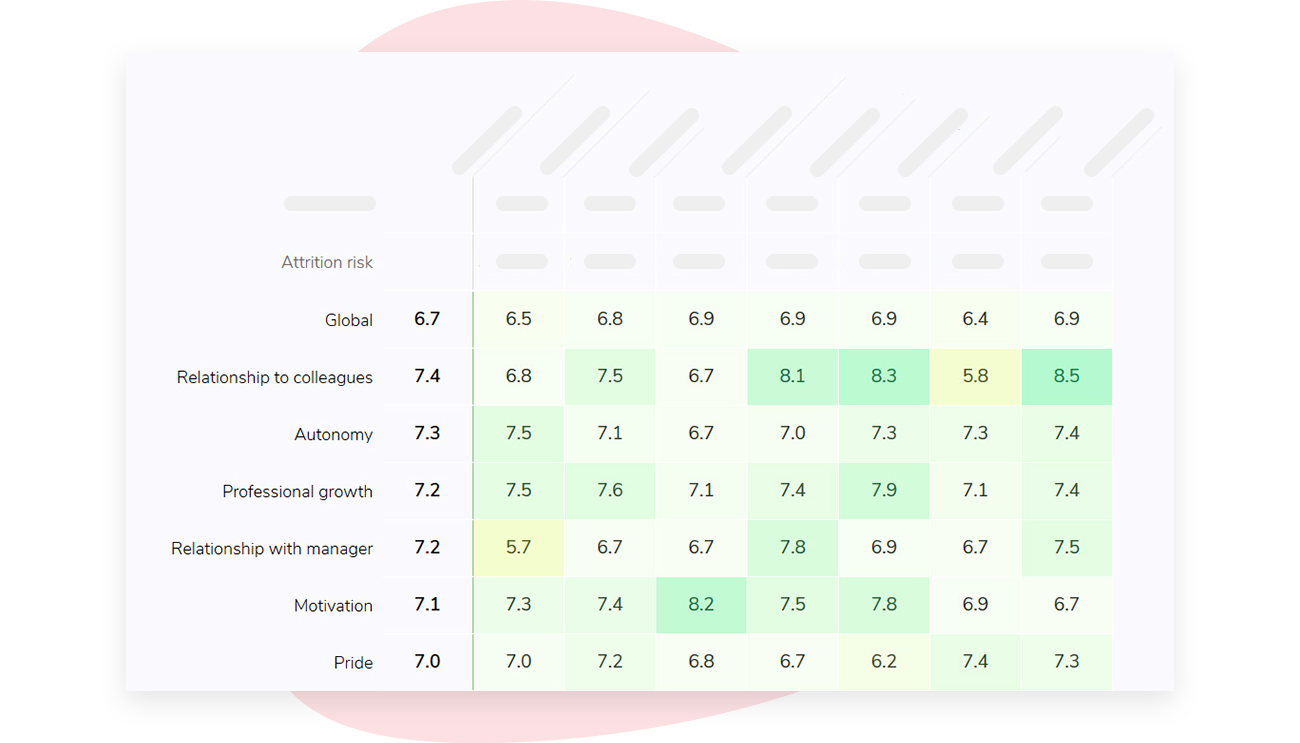
We also created a library of easy-to-implement actions from the most successful organizations to help you and your team managers learn and improve.
It’s a great way to build a culture of constant improvement, and give employees a voice that gets heard and acted on.
If you're interested in learning how Sparkbay can help you increase employee satisfaction, you can click here for a demo.
Top employee satisfaction survey questions:
Questions on employee wellbeing
- Do you feel valued for your contributions?
- Do you feel that our company takes adequate action to promote employee wellness?
Questions on career opportunity and professional growth
- Do you feel that you are growing professionally?
- Do you feel that your job allows you to develop new skills?
- Do you feel like your job utilizes your skills as much as it could?
- Do you see a path to advance your career in our company?
Questions on relationship to manager
- Does your direct manager value your opinions?
- Do you feel that your job allows you to develop new skills?
Questions on relationship to colleagues
Questions on autonomy
- Do you think you’re given enough freedom to decide how to do your work?
- Do you know what is needed to meet your goals and objectives?
- Do you have the materials and equipment you need to do your job well?
Questions on workload
- Do you find your workload reasonable?
- Do you think that work is distributed evenly across your team?
Questions on employee motivation and sense of accomplishment
Questions on company culture
Questions on job satisfaction
Questions on employee wellbeing

Do you feel valued for your contributions?
There once was an unspoken agreement between employers and employees that worker loyalty meant something.
An employee would plan for a long-term position at a company and in exchange, they’d receive decent pay, excellent healthcare coverage, robust retirement benefits, and more.
This is no longer the case. Even if you want to do right by your workers, distrust has eroded the employer-employee relationship.
In a recent study, more than half of respondents reported that they trust strangers more than they trust their own boss.
As far as today’s workers are concerned, their company isn’t interested in giving as much to their workers as possible. They’re focused on rightsizing, cost-cutting, and maximizing shareholder value.
As a result, employees are looking out for themselves.
More and more workers, particularly younger employees, are hopping from jobs every few years.
One employee survey by Robert Half found that 67 percent of workers with a college education or higher, see the most benefit in changing jobs every few years.
This means that understanding how valued employees feel is important.
For one thing, valued employees stick around and stop viewing every career decision as a zero-sum game where they’ve got to stick it to the leadership team before the leadership team sticks it to them.
It also impacts your organization’s employer brand.
You want external talent to view your company as a place where they can build a long-term career. Not a place they view as a stopover to another role.

Do you feel that our company takes adequate action to promote employee wellness?
There are several ways wellness programs benefit employers.
For starters, wellness programs encourage people to take a preventative approach to their health through activities like exercise, meditation, and healthy eating.
These preventative measures reduce the number of sick workers and as a result, rates of absenteeism.
Plus, workers who take advantage of health and wellness programs are more productive.
Research shows a link between physical exercise and cognitive benefits like enhanced focus and memory.
In fact, personal and family health problems cost U.S. employers over $225.8 billion per year!
So if you already have an employee wellness program in place, it’s important to measure how effective it is.
Asking this question on your annual job satisfaction survey helps determine whether you need to market your program more broadly or invest in a wellness package that attracts greater interest.
Questions on career opportunity and professional growth

Do you feel that you are growing professionally?
Every organization wants the best and brightest to stay and rise through the ranks.
But if there’s not a clear progression plan in place, they may be eyeing the door, even if they’re relatively happy in their role.
Why?
Top performers seek challenges, and comfort equals stagnation.
They want to feel like they’re progressing in their career and developing their skills.
Unfortunately, managers have a tendency to treat career development conversations as formalities or “checkbox” exercises.
Since these employees are superstar hires, they don’t wait around for employers to prioritize their career growth–they look elsewhere.
And this career development activity is constant. One meta-study found that “young high achievers”–30-somethings with degrees from elite institutions and international experience–are constantly keeping their eye out for new opportunities.
- Three-quarters: That’s how many people spoke to search firms or sent out resumés at least once in their first year of employment
- Almost 95%: That’s how many of these young high achievers engaged in job-seeking activities like researching prospective employers
- 28 months: Average number of months after which high achievers left their current employer
Therefore, it’s important for employers to understand how well their organization is doing with development opportunities.

Do you feel that your job allows you to develop new skills?
In the past, employees had a clear skills development path laid out for them.
They might start out as a trainee, become a specialist or a manager, and then finally wind up an executive.
HR teams created specific training programs designed to equip them with the right skills for the next milestone.
Today’s workplace is no longer like this.
The 21st century workforce calls for innovative, cross-disciplinary thinkers who can work in teams.
The need for employees to bring a combination of skills has even prompted some people to rethink their academic journeys.
One woman profiled by the Financial Times explained how she’d completed an undergraduate business degree with the intention of eventually earning an MBA.
After acquiring some work experience, she realized that what employers really needed were business-minded individuals who could speak the language of software engineers.
So she abandoned her plans to pursue an MBA and entered a data science graduate program instead.
The lesson here is that learning and development is no longer linear. This is an adjustment for corporate training teams that are overwhelmed by the number of emerging skills and how quickly they go out of date.
Consequently, they’re encouraging employees to pursue self-education or pointing them towards poorly curated learning management systems (LMS) with poor learning design.
This often does more harm than good.
When employees feel their employers aren’t helping them avoid obsolescence, they look for their own learning opportunities. And those learning opportunities are more often than not outside their current organization.
One survey found that one-third of employees left their job due to a lack of opportunities to learn new skills.
In other words, you should definitely find out how happy your employees are about the training opportunities at your organization.

Do you feel like your job utilizes your skills as much as it could?
Any business leader understands the importance of resource allocation.
You want to invest present resources into tasks that will achieve the greatest return on investment.
But this mentality is often forgotten when it comes to an organization’s workforce.
In many cases, companies don’t tap into the full potential of their employees. This is a real problem for employee engagement.
According to SHRM, 85% of employees feel like they can’t live up to their full potential at work due to skills underutilization.
On the other hand, companies can get more work done by simply asking employees about their larger skill set.
Through frequent one-on-ones, managers can get a sense of what their team brings to the table and find opportunities to maximize their potential.
Underutilization can take another form as well: lack of reskilling opportunities.
Today, 75% of HR professionals who report difficulty finding suitable job candidates say this struggle is due to a persistent skills shortage.
Meanwhile, 52% of surveyed HR professionals say the skills shortage has only worsened over the past two years.
What’s more, the option to buy new workers instead of re-skilling existing workers is disappearing.
With the demand for digital skills outstripping the number of workers on the market, companies like Amazon are investing in re-skilling opportunities that make the most of their existing workforce and set them up for success in the future.
By gauging how utilized your workforce feels, you can assess whether changes are needed.

Do you see a path to advance your career in our company?
If your employees don’t see a path for them in their current company, they’ll look for career paths at others.
Is there a clear career progression plan for every worker within your organization?
Once upon a time, employees could reasonably believe that with consistent hard work they’d continuously move up the ladder.
But the changing nature of work and modern organizations means this is no longer a safe bet.
In other words, the career ladder has been replaced by what Cathy Benko and Molly Anderson call the “career lattice”. Career progression is no longer exclusively linear.
With in-demand skills changing every few years and companies struggling to project staffing needs down the road, there’s been an increase in horizontal and diagonal career shifts.
Understandably, this causes anxiety among workers, who can’t be certain whether there’ll be a role for them in a few years time.
Your organization can gauge how concerned workers are about through your employee satisfation survey and make changes accordingly.
Questions on relationship to manager

Does your direct manager value your opinions?
Respected employees are engaged employees.
One way managers show respect for workers is by listening to their opinions and valuing their feedback.
While many managers may think their employees feel valued and respected, they may not be doing enough.
One study found that 64% of polled workers reported that leaders making decisions without soliciting their feedback was their biggest challenge.
This is no small matter. This impacts a wide range of factors including employee morale, engagement, and even initiative.
In one poll, 38% of employees said that when leaders dismissed their ideas without considering them, it led to a decreased sense of initiative.

Does your direct manager provide the support you need to complete your work?
Imagine having the skills to do great work, but not enough resources or support to do so?
Great managers understand what each of their employees need and take steps to provide that.
In some cases, it’s one-on-one meetings to review priorities, discuss obstacles, and provide tips.
In other cases, it’s about identifying an employee’s unique strengths and assigning tasks that make the most of them.
There are also instances in which employees need their manager to remove specific obstacles.
This could be about getting team members access to specific resources or even facetime with senior members of another team.
If your survey results show that workers don’t feel supported, you have the data you need to champion additional training for the people managers within your organization.
Questions on relationship with colleagues

Do you enjoy the colleagues you work with?
The presence of work friends has a number of positive effects on an employee’s work experience.
A kindred spirit in the office can increase employee job satisfaction and even a person’s possibility of advancement within the workplace.
One Gallup poll found that 63% of women who said they have a work friend said they felt engaged at work.
On the flip side, only 23% of women who didn’t have a work friend said they felt engaged.
Plus, today’s workers expect more from their job than just a paycheck, especially when they’re highly skilled workers who are in demand.
They seek a great company culture where they have genuine bonds with the people they work with.
Measuring the quality of your workers’ relationships is one way to assess their level of happiness at work.
It also helps you decide whether you need to invest more in company events for internal networking opportunities.
Questions on autonomy

Do you think you’re given enough freedom to decide how to do your work?
Micromanagement damages productivity.
By definition, a manager isn’t supposed to be doing the work.
A manager manages a group of people with diverse skills.
They bring these individuals together, and coordinate activities, keep a project on track, ensure they have the resources they need, and eliminate any obstacles that may stand in the team’s way.
When a manager starts overstepping by choosing to do the work themselves or hovering over subordinates, it has a negative impact over the long term.
Sure, they may get that specific task completed, but they do so at the expense of their larger managerial duties.
Micromanagement doesn’t just affect productivity. It affects employee job satisfaction as well.
When managers consistently step in to correct or over-analyze, they alienate employees from their work, creating a sense of disengagement.
By asking employees whether they have enough freedom in their day-to-day work, employers can assess the level of micromanagement present in their workforce.

Do you know what is needed to meet your goals and objectives?
Employees who have clear goals can take the steps they need to succeed.
On the other hand, when their day-to-day work feels disconnected to a meaningful goal or objective, it’s easy to become disconnected from the work altogether.
Goals and objectives also determine an employee’s career progression, pay increases, and bonuses.
If goals and objectives aren’t clear, and annual performance reviews are not satisfactory, this can lead to resentment and dissatisfaction among employees who feel let down by a company’s evaluation system.
On the other hand, if managers clearly define goals, give employees the information and guidance they need to successfully meet them, employees can feel like active participants in their organization.
Figuring out how involved employees feel sooner rather than later is a smart approach.

Do you have the materials and equipment you need to do your job well?
Denied resource requests are a huge source of frustration for employees.
They’re trying to work to the best of their abilities, but they are constantly denied the people and tools they need.
As a result, they have to spend time on non-value generating tasks to make up for substandard resources.
After some time, they may question whether their current organization values their skills and whether they should consider a different organization with the resources they need to succeed.
This often comes down to a misalignment in perspectives.
Employees are focused on maximizing their individual contributions while employers are focused on staying in line with their budget.
While fiscal responsibility is important, your organization doesn’t want cost-cutting to come at the expense of employee morale (which leads to the even more expensive phenomenon of high employee turnover).
An annual check-in helps you assess how many employees feel they don’t have the tools they need to succeed and whether a change is needed.
Questions on workload
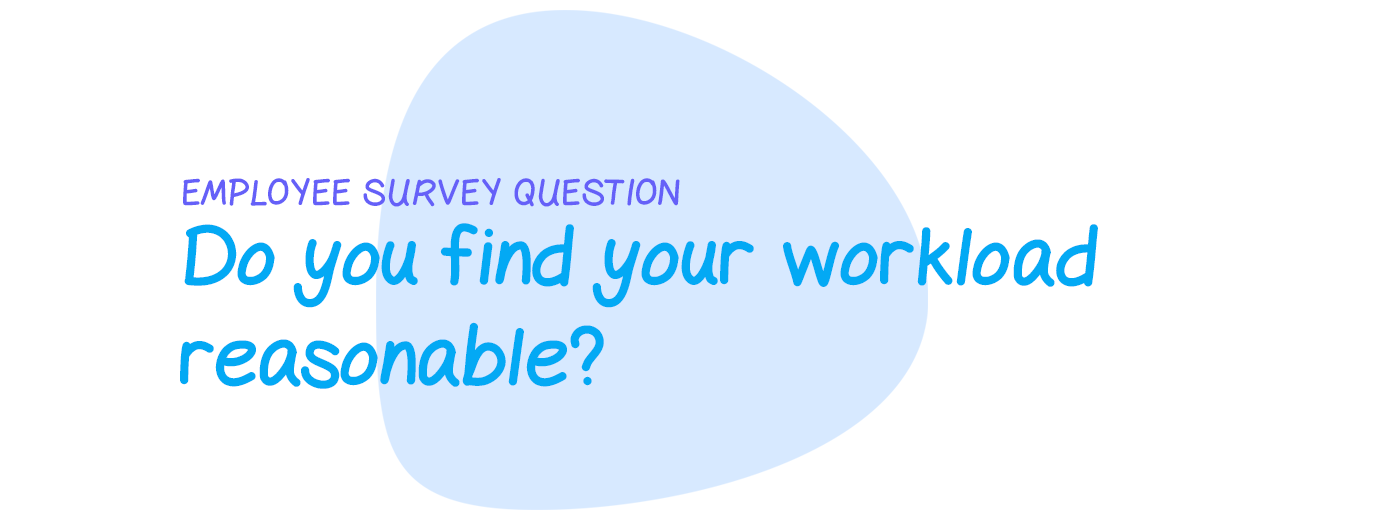
Do you find your workload reasonable?
Experts consider burnout a growing public health crisis, but employees in high-powered fields like finance, consulting, and law hesitate to seek the help they need.
Oftentimes, this is due to a combination of workplace culture and an employee’s perfectionist tendencies.
In one survey of over 450 individuals from 43 countries around the world, the majority said they felt unsupported and alienated based on their mental health.
Two-thirds said their work had a negative impact on their mental health while 44 percent said they didn’t think their company took mental health seriously.
Even the most well-intentioned leaders can’t register the individual mental health or stress levels of all their employees. Employee surveys are a helpful way to understand the level of employee stress, at the macro level.
This larger understanding can help leaders make organizational changes to the company culture by introducing more support and resources for employees.

Do you think that work is distributed evenly across your team?
It goes without saying that work should be distributed evenly among teams.
But just because everyone agrees on this in theory, doesn’t mean things always happen that way.
For instance, a manager may recognize the need for fairness, but give into the temptation to assign the bulk of the work to the most productive employee.
This gets the work done in the short term, but it leads to resentment over the long term.
Research using Microsoft’s Workplace Analytics product found that workers who work 120% more hours than their peers are 33% more likely to be disengaged.
They’re also more likely to view the management team less favorably.
So not only is your organization left with unhappy employees, your organization is left with unhappy top-performing employees.
These are the people you want to hang on to the most.
As a result, it’s important to check in and make sure your employees feel a sense of fairness in how they’re treated by their boss.
Questions on employee motivation and sense of accomplishment

Do you feel a sense of accomplishment from what you do?
People enjoy a sense of accomplishment, but for knowledge workers this is harder to find.
Unlike hands-on work like farming or manufacturing, the sorts of tasks knowledge workers complete are often intangible or happen in teams.
And often, there’s a time lag between finishing the work and witnessing any results.
This means employees often don’t get that jolt of satisfaction or sense of accomplishment that comes from completing a project.
When employees don’t feel a sense of accomplishment, it’s hard for them to feel connected to their work and therefore, engaged.
This isn’t an impossible problem to fix. Employers can create a sense of accomplishment among knowledge workers by creating metrics tied to reality.
As a former auto claims worker explained to the Wall Street Journal, his company would weigh brief check-in calls the same as longer claims calls when tallying up metrics.
At the same time, they didn’t have a metric to reward workers who turned a potentially negative call with a frustrated customer into a positive experience, something that worker found particularly rewarding.
If your annual survey finds that employees don’t feel a sense of accomplishment, you’ve got an opportunity to demonstrate the real world value of your company’s work and create metrics that recognize the right contributions.

Do you find your work meaningful?
People want more than a paycheck from their work. They want a sense of meaning.
So much so that one study found, on average, respondents were willing to give up 23% of their lifetime earnings for work that was always meaningful.
And what about the benefit to your organization? Well, it turns out that employees who feel they’re doing meaningful work spend one extra hour at work per week.
They also take two fewer paid leave days. What’s more, happier workers are more productive workers. Harvard Business Review calculated the ROI of productive workers at about $9,078 per worker per year.
In other words: It pays to find out whether your employees find their work meaningful.
Sparkbay allows us to get honest employee feedback. The insights we get around employee engagement enable us to be more proactive and fuel quality conversations.
How Exegy® used a data-driven approach to improve engagement with Sparkbay
Questions on company culture

Do you enjoy our company’s culture?
Company culture, or as Deloitte puts it, “the way things work around here”, has become a C-level priority.
It’s easier than ever for current and former employees to share their opinions about a company’s operations online.
Internal communications departments no longer control the narrative.
But why should you ask this question on your employee survey?
After all, the other questions on the survey are meant to tackle the issue of culture in detail.
Well, this general question helps you do two things:
- Gauge how well (or how badly) things are going
- Focus your game plan for improving or maintaining your company culture
If people answer positively to this question, then you know that overall, you have a good reputation and you can focus on maintenance rather than an emergency overhaul.
On the other hand, if an overwhelming proportion of respondents reply negatively to this question, you’ve got a big project on your hands.
In this case, you can use the specific responses to prioritize your changes over the next year and create a game plan.
Questions on job satisfaction
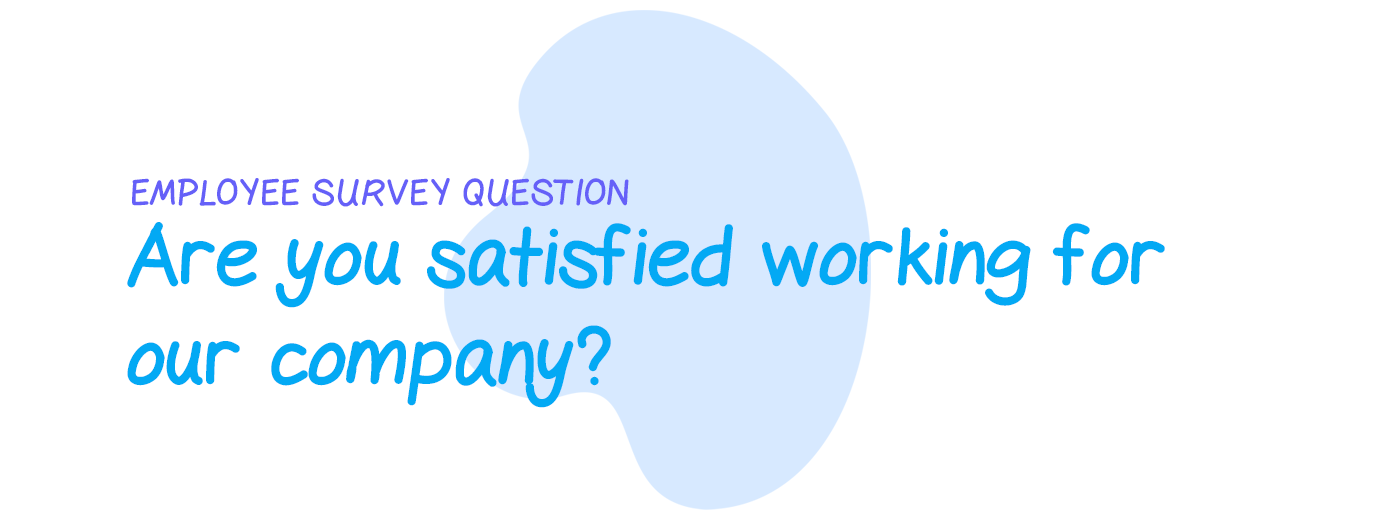
Are you satisfied working for our company?
Ask your employees whether they’re satisfied at your company. You might be surprised at how honest your employees will be.
For instance, one company found that simply asking employees how long they plan to stay produced more honest answers than using AI to measure metrics like email response rates.
This will also help you put your other answers in context.
If workers state they are satisfied, you’ll know what is keeping them happy based on the rest of your survey.
On the other hand, if workers are dissatisfied, you can identify the root cause of their dissatisfaction.

Would you recommend our company to friends and family?
Your company’s success relies on its ability to attract skilled workers in a tight job market.
And if you’ve already hired the best and the brightest, homophily in social networks increases the likelihood that they know other talented high achievers.
If your current employees aren’t happy in their role, they’ll share their experience with their friends and family who won’t want to join them.
Understanding whether your employees would recommend your company is not only important for your retention efforts–it’s important for your recruitment efforts, too.
The benefits of a robust employee survey platform
A robust employee survey platform such as Sparkbay can help leaders understand obstacles and opportunities and focus their efforts where it matters. It can also track engagement and satisfaction over time to identify which actions are working and which aren't.
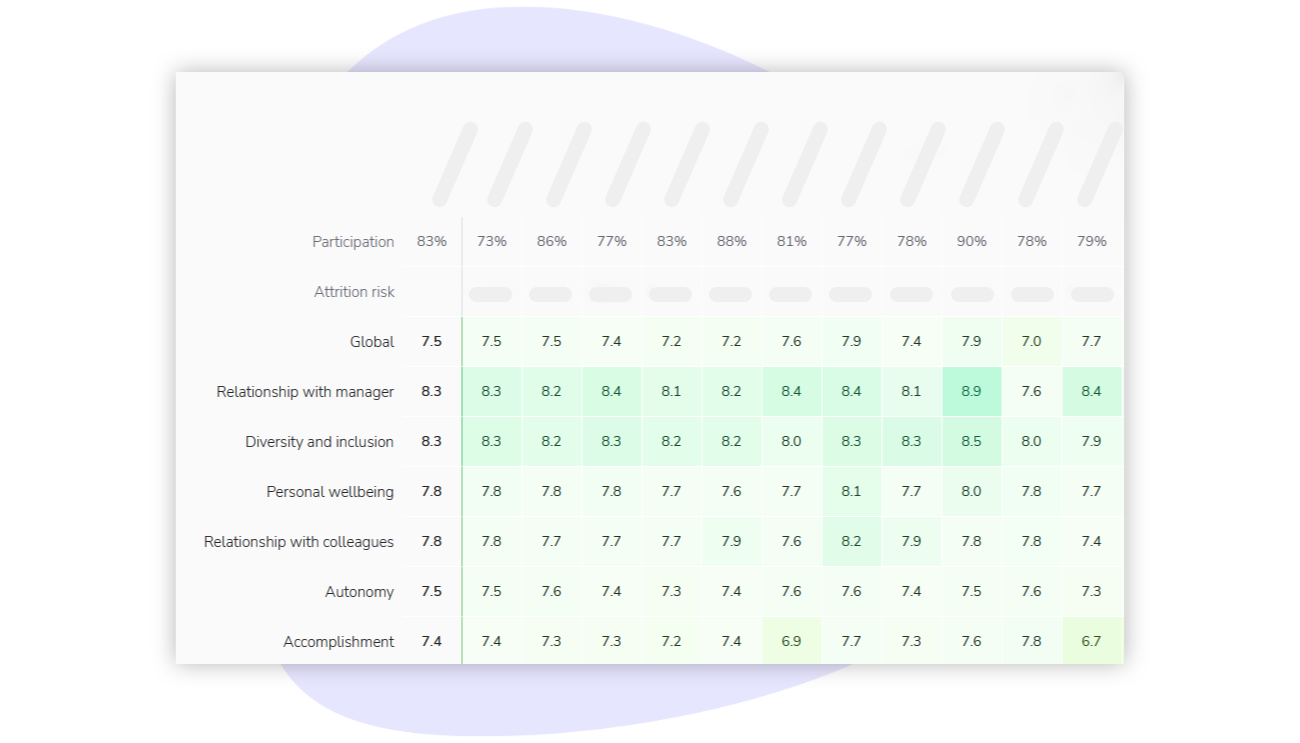
Explore employee data any way you want
It is important to be able to segment data based on demographics such as tenure and role. Sparkbay allows leaders to interrogate their data in any way they want to uncover deeper insights about their people.
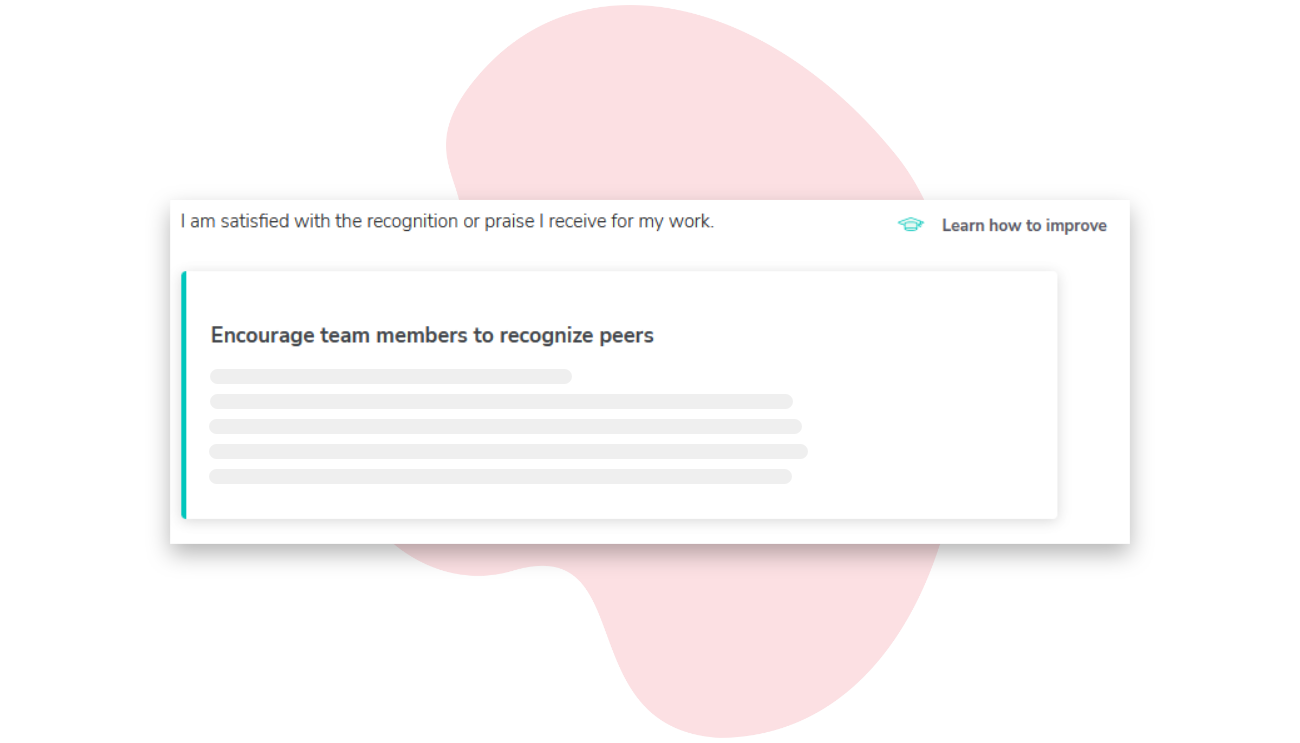
Empowers action
Surveying employees serves no purpose if leaders do not take advantage of the opportunities they discover. With Sparkbay's automated coaching, managers can act on easy-to-implement strategies. These tools drive action to ensure you meet your employee-centric objectives.
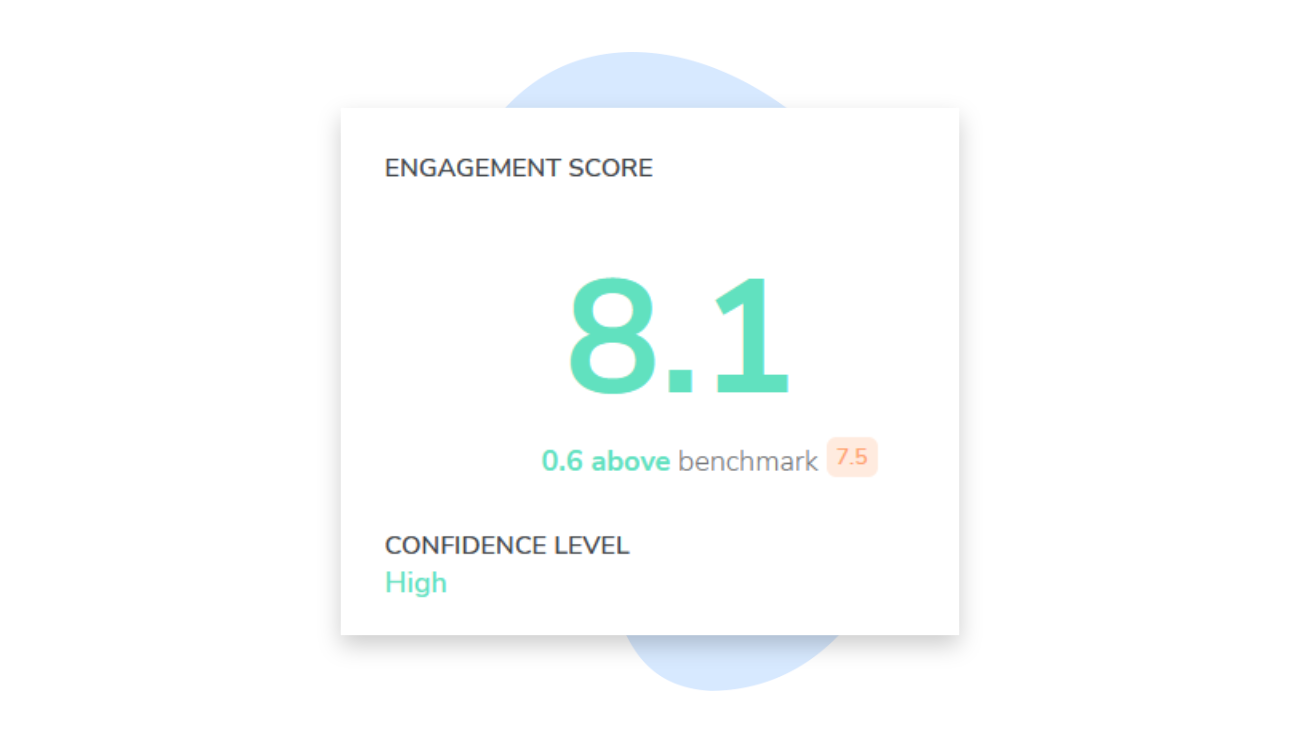
Provides robust benchmarks
Leaders need to compare their survey results with industry benchmarks to understand how they are doing. Using the right survey platform, you can compare your survey data with others in your industry, similar-sized companies, and top employers.
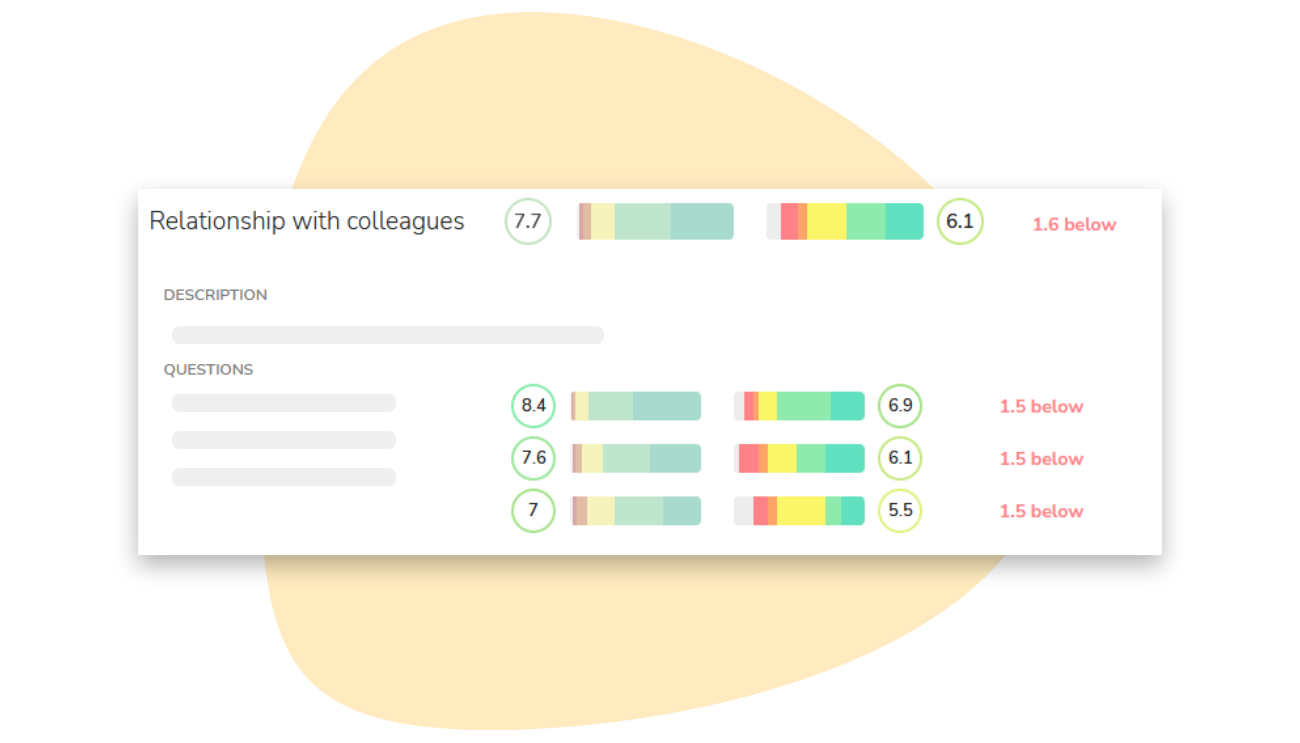
Equips managers with dashboards to visualize their results
Manager dashboards help managers visualize their survey results all in one place. With these dashboards, managers can easily track employee experience trends, and identify strengths and opportunities.
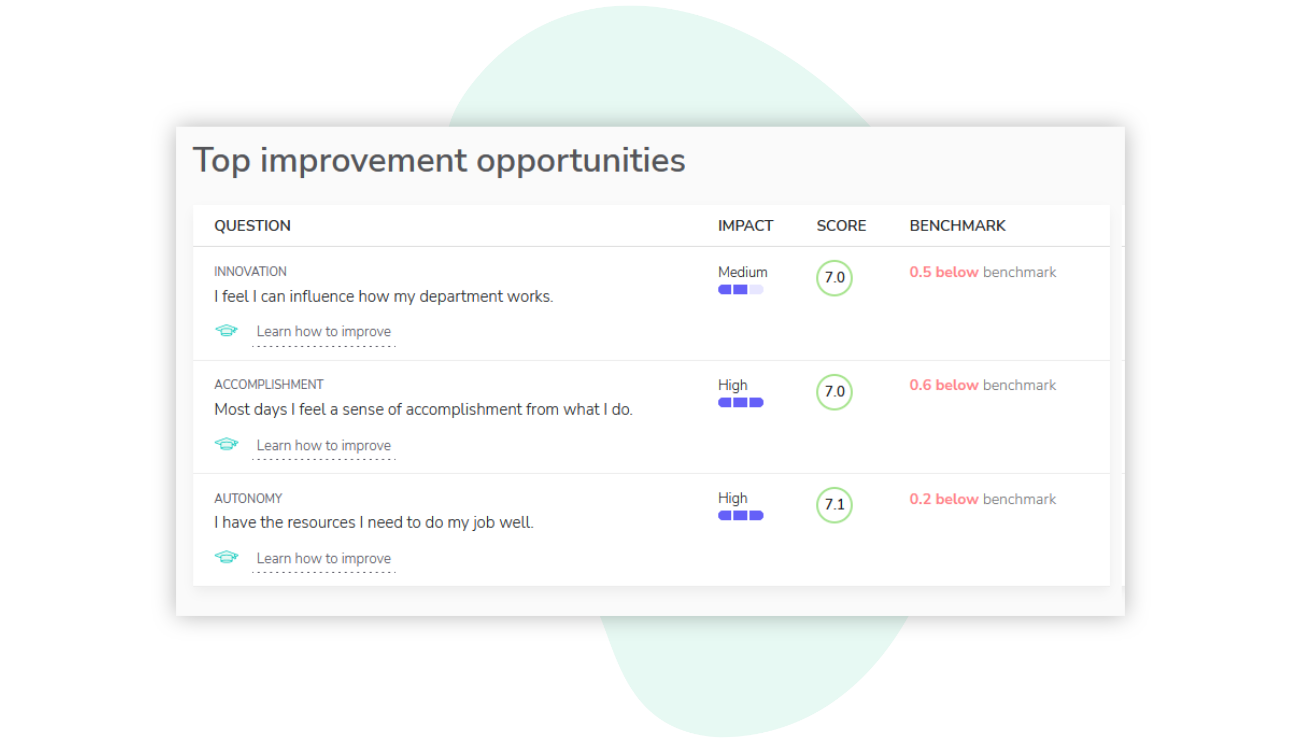
Provides a seamless user experience
You don't want your managers to waste valuable time on a clunky, hard-to-use platform. We designed Sparkbay with simplicity in mind. Your managers will master our intuitive dashboards in no time.

Gain access to real-time results
Taking action is the most significant part of your survey strategy. That’s why Sparkbay's real-time results let you expedite your process and propel insights into action.
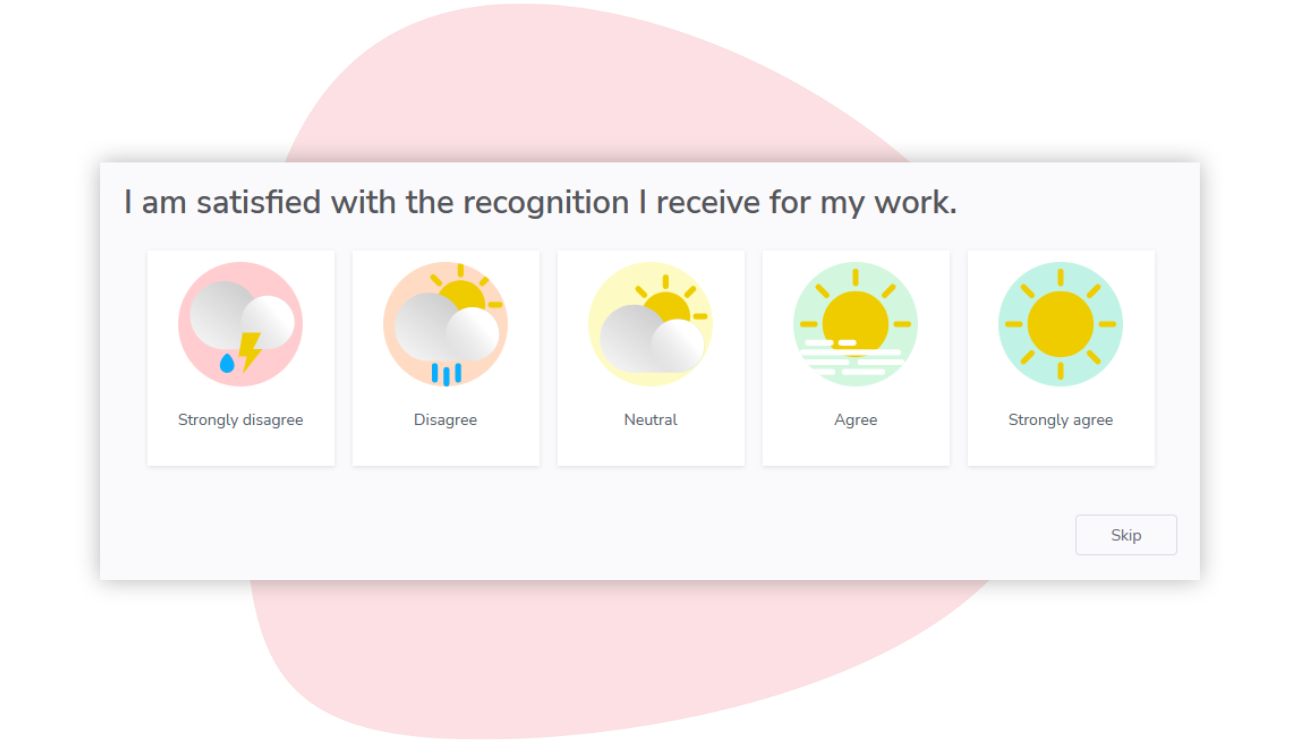
Offers science-backed questions on key workplace topics
To get the insights you need, you have to ask questions that resonate. Sparkbay offers science-backed questions on key workplace topics such as diversity and inclusion, change management, employee benefits, and more.
Measuring and improving employee satisfaction through employee pulse surveys is straightforward and effective when you adopt an approach that works.
By using a robust employee survey platform to administer the right survey questions, you can easily collect employees’ feelings and sentiments to put these insights into context.
If you're interested in learning how Sparkbay can help you survey your employees, you can click here for a demo. You can also download your free employee satisfaction survey template here.
7 Proven Employee Retention Strategies in 2026
12 Employee Engagement Survey Questions You Need To Ask in 2026
Employee Exit Interviews: Top Questions & Best Practices
23 Essential WFH Survey Questions for Remote Staff
14 Professional Development Survey Questions You Need to Ask

